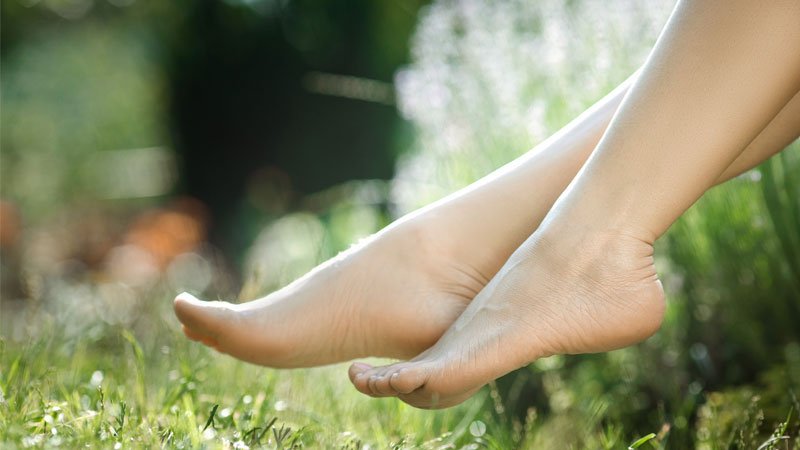Fungal nail infections can be a bit of a showstopper if you want to get your feet out in Summer. Not only can they look unsightly if you’re wearing open-toe shoes, but they’re also highly contagious, and easier to catch in Summer when walking barefoot in communal places.
What causes a fungal nail infection?
Fungal nail infections (onychomycosis) are quite common and thought to affect approximately 1 in 4 people. The main cause is a type of fungus called dermatophyte which also causes athlete’s foot. Most nail infections start with athlete’s foot, which infects the skin before spreading to the keratin of the nail. Yeast (e.g. candida) and moulds may also cause an infection but tend to attack a nail that is already damaged.
Fingernails and toenails can be infected but it is most common on the toes – particularly the big toe. Older people are more prone to infection as the nails become drier and brittle with age, which allows the fungus to creep in. Health problems such as poor peripheral circulation, diabetes, psoriasis, or a weakened immune system can also increase the risk, as can smoking.
Symptoms of fungal nail infections
The infection usually starts at the tip of the nail and spreads down the side towards the cuticle. The entire nail may eventually be affected. Signs of infections include:
- White or yellow spots/streaks on the nail
- Nail becoming thick, difficult to trim, rough or brittle with bits breaking off
- Nail loses its natural lustre and shine
- Loosening or lifting of the nail
- Nail changing shape
- Pain or swelling of the skin around the nail
Preventing infection
Fungus likes to grow in warm, damp environments, so you’re more likely to develop an infection if you suffer with hot, sweaty feet and if you wear occlusive footwear such as socks, trainers or work boots for long periods of time.
Fungal nail infections are contagious so walking barefoot in communal places such as pools, changing rooms, showers, or hotel bathrooms can increase the risk. Sharing contaminated items such as nail clippers, bedding, towels, clothes, or shoes can also spread the infection.
Fingernail infections are more common if you bite your nails, wear artificial nails or nail polish for longer periods of time, or if your hands are exposed to lots of ‘wet’ work (e.g. cleaning).
It may help to take the following precautions:
- Dispose of old shoes, particularly trainers that have been used for exercise
- Choose comfortable, well-fitting shoes (avoid high heels and narrow shoes) and wear cotton socks that allow the feet to breathe
- Keep your toenails trimmed and clean. Cut or file straight across – not in a rounded or v shape and do not trim your cuticles – use a cuticle pusher instead
- Dry your feet and nails properly after a bath, shower, or swimming
- Avoid walking barefoot in public places – take flip flops to the swimming pool or gym
- Make sure athlete’s foot is treated promptly to prevent it spreading to the nail
- Have two sets of nail accessories (e.g. clippers) to avoid cross-contamination between infected and healthy nails
- Wash and dry your hands properly after contact with infected nails
- Don’t leave nail polish on for too long as it may cause yeast, mould and bacteria to develop under the nail
Treating fungal nail infections
Fungal infections will not clear up on their own, but if the symptoms are mild you may not need treatment. If they become uncomfortable or embarrassing, treatment options are as follows:
Anti-fungal topical solutions (nail paints / creams) can be effective if the infection is caught early but need to be used for quite a long period of time (4-12 months) before an improvement is seen. They may also not clear the deeper parts of the infection.
Oral treatments (tablets) can also be prescribed by your GP. These tend to be more effective than topical solutions but are more likely to cause unwanted side-effects such as skin allergies, headaches, nausea, and diarrhoea.
If you wish to try a more natural treatment for nail fungus, Tea Tree essential oil is a particularly good choice because it contains terpenoids, which are known for their ability to kill dermatophytes (the main cause of nail infections). A study conducted back in 1994 found that Tea Tree oil was as effective in treating fungal toenail infections as the antifungal drug clotrimazole.
Lemongrass essential oil is also a natural fungicide and can be used in conjunction with Tea Tree.
To make a natural treatment oil mix 3 drops of Tea Tree and 2 drops of Lemongrass with 10ml of Neem carrier oil which also has antifungal properties. Ensure the infected nail is clean and thoroughly dry and apply the oil to the affected nail and cuticle area with a cotton bud, two to three times a day until the infection clears.
You can also read our general advice on caring for your feet and treating athlete”s foot here.
Treating a fungal nail infection can be a lengthy process because nails grow slowly, so you may only see an improvement as your new nail grows through. It may be 6 to 12 months after treatment before the nail looks normal again. It’s also not uncommon for nail infections to re-occur. Following the self-care measures above may help prevent recurrent infections.
If an infection is severe or extremely painful and does not respond to treatment you should see your GP who may recommend that the nail is permanently removed.
Important safety advice
Serious infections left untreated can lead to cellulitis (an infection of the deeper layers of the skin and underlying tissue) or a bone infection. Seek the advice of a GP if you are concerned. People with diabetes or a suppressed immune system should seek professional treatment to avoid the significant risk of more serious health problems.
Sharon Lovett
Marketing Manager

